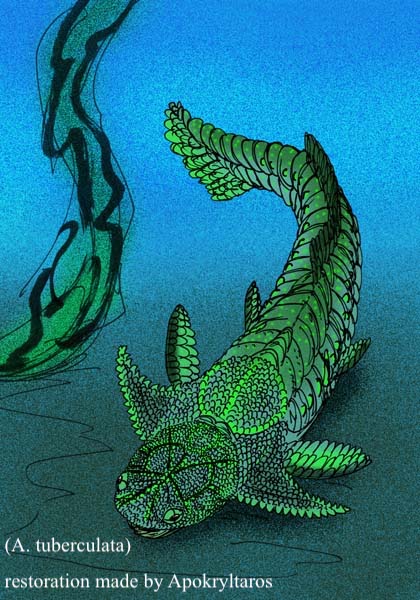Welcome to Actinolepis

Name Definition
Ray/beam scale
Name Given By
Louis Agassiz in 1845/A. tuberculata ; Elga Mark-Kurik in 1973/A. magna ; Elga Mark-Kurik in 1985/A. spinosa ; Dmitry P. Plax and Michael J. Newman in 2020/A. zaikai
Location
Belarus (Lepel Beds), Estonia, Latvia (Sevy Dolomite), and New Zealand (Adam Mudstone Formation)
Classification
Vertebrata, Gnathostoma, Placodermi, Arthrodira, Actinolepidae
Size
unavailable
Temporal Range
Pragian - Eifelian stages of the Early - Mid Devonian, approximately 409 - 392 million years ago
Ecological niche
small benthic predator
Species/Sub Species
A. tuberculata (type species), A. magna, A. spinosa, A. zaikai
Diet
Like other actinolepid fish, Actinolepis probably fed on soft bodied animals such as soft-bodied molluscs and worms
Introduction
Actinolepis is a genus of actinolepid arthrodire fish that lived in Europe and New Zealand during the Early - Mid Devonian.
While there have been scales associated with Actinolepis that were found in Europe, we know that there is at least one species of Actinolepis that lived in Devonian New Zealand which is Actinolepis tuberculata. However, back in the Devonian, the landmasses of Earth were very differently arranged compared to how our continents are positioned today, and New Zealand was off the coast of Gondwana during the Devonian which consisted of Africa, South America, Australia, and Antarctica, and New Zealand is right off the coast of Australia. Because all the continents were connected into large supercontinents, it was easy for Paleozoic animals like Actinolepis to expand their geographical range more than animals today, which is why some Paleozoic animals were so widespread.
Actinolepis was a placoderm fish, like the more iconic Dunkleosteus, and they were among some of the first jawed fish to ever appear. Actinolepis was placed in the placoderm order Arthrodira, meaning that they were able to move the joints between their armor on their heads and bodies, and they did not possess true teeth, but rather they had sharpened bony projections that were part of their jaw bones, which made them look like they had large and sharp teeth. The family Actinolepis was in, the Actinolepidae, consisted of some of the most primitive arthrodire placoderms in the Placodermi class. They had dorsoventrally compressed bodies which meant that most of the fish in this family would have lived in the benthic zone. Their jaws were rather underdeveloped compared to the later arthrodires that possessed more robust jaws for crushing, which probably meant that Actinolepis and other actinolepids hunted soft-bodied animals such as soft-bodied molluscs and worms as they were not adapted to hunt larger and tougher aquatic animals.